The global flat nylon webbing market is projected to grow from USD 842.9 million in 2025 to approximately USD 1212.3 million by 2035, recording an absolute increase of USD 369.4 million over the forecast period. This translates into a total growth of 43.8%, with the market forecast to expand at a compound annual growth rate (CAGR) of 3.7% between 2025 and 2035. The overall market size is expected to grow by 1.4X during the same period, supported by increasing demand from automotive safety applications, expanding outdoor equipment manufacturing across consumer sectors, and growing adoption of high-strength textile solutions requiring superior load-bearing characteristics in industrial and safety equipment applications.
The flat nylon webbing sector demonstrates steady expansion patterns driven by consistent automotive production volumes, particularly in Asia Pacific manufacturing centers where vehicle safety component production maintains sustained growth trajectories. Outdoor equipment manufacturing and recreational gear applications provide additional demand channels, with performance requirements in safety harnesses and cargo restraint systems supporting premium webbing adoption. Manufacturing investments in China and India create substantial procurement opportunities, while established European and North American operations maintain quality-focused material specifications for safety-critical applications.
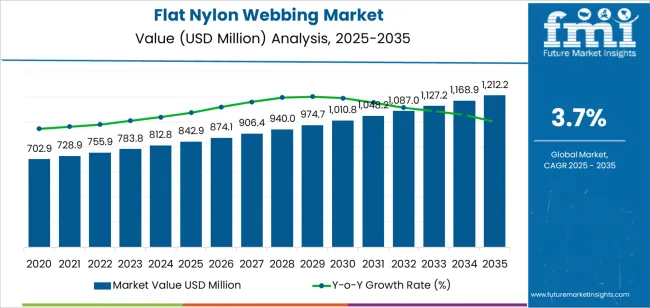
Material performance characteristics position flat nylon webbing as essential components in load-bearing and safety applications. These textile products deliver tensile strength, abrasion resistance, and environmental durability benefits that alternative materials cannot match. Technical specifications for breaking strength, elongation properties, and UV resistance establish market entry requirements that favor established producers with comprehensive testing capabilities. Supply chain relationships between webbing manufacturers and automotive component suppliers create switching costs through safety certification requirements, quality validation expectations, and technical support dependencies.
| Metric | Value |
|---|---|
| Market Value (2025) | USD 842.9 million |
| Market Forecast Value (2035) | USD 1212.3 million |
| Forecast CAGR (2025-2035) | 3.7% |
| AUTOMOTIVE SAFETY EXPANSION | INDUSTRIAL APPLICATION REQUIREMENTS | PERFORMANCE MATERIAL STANDARDS |
|---|---|---|
| Vehicle Production Growth | Load-Bearing Requirements | Safety Certification Standards |
| Continuous expansion of global automotive manufacturing capacity across emerging markets driving sustained demand for safety webbing components. | Modern industrial applications require high-strength textile materials delivering precise load control and enhanced durability performance. | Regulatory requirements establishing performance benchmarks favoring high-quality synthetic webbing materials. |
| Safety System Enhancement | Equipment Manufacturing Demands | Quality Specification Requirements |
| Growing vehicle safety feature adoption and restraint system complexity creating sustained webbing demand supporting component production. | Outdoor equipment manufacturers and industrial safety gear producers investing in premium materials offering consistent performance while maintaining operational efficiency. | Quality standards requiring superior tensile strength and resistance to environmental stresses in demanding applications. |
| Commercial Vehicle Segment | Processing Efficiency Focus | Material Testing Compliance |
| Increasing commercial vehicle production and cargo restraint system requirements driving advanced webbing specifications supporting load security applications. | Component manufacturers with proven technical capabilities required for safety-critical webbing applications. | Diverse regulatory requirements and safety standards driving need for certified textile materials. |
| Category | Segments Covered |
|---|---|
| By Product Type | Normal Type, Heavy Type |
| By Application | Automotive, Outdoor and Recreational Equipment, Safety and Rescue Gear, Others |
| By Region | North America, Europe, Asia Pacific, Latin America, Middle East & Africa |
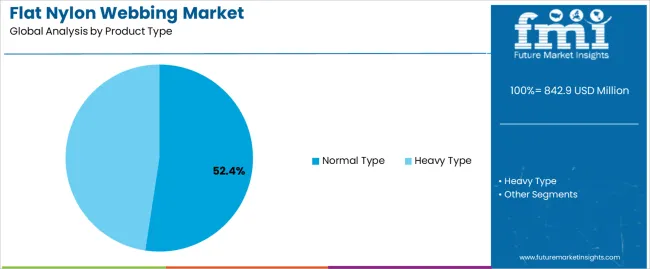
| Segment | 2025 to 2035 Outlook |
|---|---|
| Normal Type |
|
| Heavy Type |
|
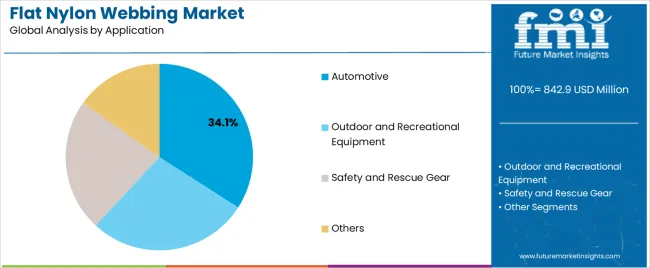
| Segment | 2025 to 2035 Outlook |
|---|---|
| Automotive |
|
| Outdoor and Recreational Equipment |
|
| Safety and Rescue Gear |
|
| Others |
|
| DRIVERS | RESTRAINTS | KEY TRENDS |
|---|---|---|
| Automotive Production Expansion | Raw Material Price Volatility | High-Tenacity Yarn Integration |
| Continuous expansion of vehicle manufacturing capacity across emerging markets driving sustained webbing demand for safety component production. | Price fluctuations in nylon polymer feedstocks affecting production costs and margin predictability for webbing manufacturers. | Integration of advanced high-tenacity nylon yarns, enhanced weaving technologies, and finishing process innovations enabling superior strength-to-weight performance. |
| Outdoor Recreation Growth | Competition from Alternatives | Custom Dyeing Capabilities |
| Increasing outdoor activity participation and adventure equipment adoption creating demand for durable webbing solutions. | Alternative materials including polyester webbing and polypropylene straps presenting competitive pressure in cost-sensitive applications. | Development of specialized dyeing processes and color-matching capabilities providing enhanced aesthetic customization. |
| Safety Equipment Standards | Manufacturing Complexity | Sustainable Material Options |
| Growing workplace safety regulations and rescue equipment requirements creating opportunities for certified webbing products. | Technical expertise requirements and quality control investments increasing operational complexity for safety-critical applications. | Enhanced recycled nylon integration and bio-based material development providing environmentally responsible product alternatives. |

| Country | CAGR (2025-2035) |
|---|---|
| China | 5% |
| India | 4.6% |
| Germany | 4.3% |
| Brazil | 3.9% |
| USA | 3.5% |
| UK | 3.1% |
| Japan | 2.8% |

Revenue from flat nylon webbing in China is projected to exhibit strong growth with a market value of USD 296.3 million by 2035, driven by expanding automotive manufacturing infrastructure and comprehensive outdoor equipment production industry development creating substantial opportunities for webbing suppliers across safety component operations, recreational gear applications, and industrial equipment sectors.
The country's automotive production leadership and expanding consumer goods manufacturing capabilities are creating significant demand for both standard and specialized webbing products. Major automotive component manufacturers and outdoor equipment producers are establishing comprehensive local production facilities to support large-scale manufacturing operations and meet growing domestic and export demand for reliable textile solutions.
Automotive safety component modernization programs are supporting widespread adoption of certified webbing materials across restraint system production operations, driving demand for high-performance textile products. Outdoor equipment manufacturing expansion and recreational gear production growth are creating substantial opportunities for webbing suppliers requiring reliable performance and cost-effective processing solutions. Export-oriented manufacturing and international quality standard compliance are facilitating adoption of premium webbing specifications throughout major production regions.
Revenue from flat nylon webbing in India is expanding to reach USD 198.5 million by 2035, supported by extensive automotive component manufacturing capacity additions and comprehensive outdoor equipment industry development creating sustained demand for reliable webbing materials across diverse application categories and specialized product segments. The country's growing vehicle production and expanding recreational goods manufacturing are driving demand for webbing solutions that provide consistent performance characteristics while supporting cost-effective production requirements. Automotive suppliers and equipment manufacturers are investing in local sourcing facilities to support growing manufacturing operations and domestic market demand.
Automotive sector growth and safety component production expansion are creating opportunities for webbing materials across diverse manufacturing segments requiring reliable performance and competitive processing costs. Manufacturing infrastructure development and quality standard advancement are driving investments in webbing supply chains supporting technical requirements throughout major industrial regions. Outdoor equipment manufacturing growth and sports goods production programs are enhancing demand for textile materials throughout major production centers.
Demand for flat nylon webbing in Germany is projected to reach USD 23.5 million by 2035, supported by the country's leadership in automotive manufacturing and advanced textile technologies requiring sophisticated webbing systems for premium vehicle safety applications and industrial equipment. German automotive component manufacturers and equipment producers are implementing high-quality webbing materials that support advanced safety specifications, operational reliability, and comprehensive quality protocols. The market is characterized by focus on technical performance, material consistency, and compliance with stringent automotive and safety standards.
Automotive manufacturing investments are prioritizing advanced webbing materials that demonstrate superior tensile strength and durability while meeting German automotive and safety certification standards. Technical excellence programs and quality assurance initiatives are driving adoption of precision-engineered textile products that support advanced safety systems and performance requirements. Research and development programs for automotive safety enhancement are facilitating adoption of specialized webbing specifications throughout major automotive and industrial centers.
Revenue from flat nylon webbing in Brazil is growing to reach USD 110.7 million by 2035, driven by automotive manufacturing development programs and increasing vehicle production capacity creating sustained opportunities for webbing suppliers serving both original equipment manufacturers and aftermarket component operations. The country's expanding automotive industry and growing commercial vehicle segment are creating demand for webbing materials that support diverse safety specifications while maintaining performance standards. Component manufacturers and equipment suppliers are developing procurement strategies to support operational efficiency and quality requirements.
Automotive manufacturing modernization programs and safety component production expansion are facilitating adoption of webbing materials capable of supporting diverse performance requirements and competitive cost structures. Outdoor equipment manufacturing development and industrial safety gear programs are enhancing demand for textile materials that support operational reliability and performance consistency. Domestic production capacity additions and import substitution initiatives are creating opportunities for local webbing manufacturing capabilities.
Demand for flat nylon webbing in USA is projected to reach USD 71.9 million by 2035, driven by premium automotive safety systems and specialty outdoor equipment capabilities supporting advanced recreational applications and comprehensive industrial requirements. The country's established outdoor recreation industry and specialized safety equipment sectors are creating demand for high-quality webbing materials that support operational performance and technical standards. Webbing manufacturers and textile suppliers are maintaining comprehensive technical capabilities to support diverse application requirements.
Premium automotive component manufacturing and specialty equipment production programs are supporting demand for certified webbing materials that meet rigorous performance and safety standards. Outdoor recreation equipment development and industrial safety gear programs are creating opportunities for specialized webbing that provides comprehensive performance support. Quality enhancement and material optimization programs are facilitating adoption of advanced webbing specifications throughout major manufacturing facilities.
Revenue from flat nylon webbing in UK is growing to reach USD 63.9 million by 2035, supported by specialized automotive component operations and industrial equipment manufacturing capabilities serving safety equipment and technical applications. Post-Brexit supply chain adjustments have created opportunities for domestic webbing suppliers while maintaining quality specifications required by automotive and equipment manufacturers. Technical expertise in safety equipment production supports demand for certified webbing materials.
Industrial safety equipment and specialized outdoor gear applications drive consistent webbing consumption, with professional equipment manufacturers and safety product suppliers providing stable demand channels. Regulatory compliance requirements and safety certification standards favor established webbing suppliers with comprehensive testing documentation and quality assurance capabilities. Manufacturing consolidation trends concentrate purchasing power with larger operations while creating opportunities for specialized material solutions.
Demand for flat nylon webbing in Japan is projected to reach USD 70.3 million by 2035, expanding at a CAGR of 2.8%, driven by automotive manufacturing excellence and precision textile processing capabilities supporting advanced safety standards and comprehensive quality applications. The country's established automotive tradition and stringent material requirements are creating demand for high-specification webbing products that support operational performance and regulatory standards. Webbing manufacturers maintain comprehensive quality capabilities to support exacting application requirements.
Automotive component manufacturing and precision equipment production programs are supporting demand for certified webbing materials that meet rigorous strength and reliability standards. Quality assurance systems and material testing requirements are creating opportunities for specialized webbing that provides comprehensive performance verification. Precision manufacturing and safety compliance programs are facilitating adoption of advanced webbing capabilities throughout major automotive and industrial facilities.
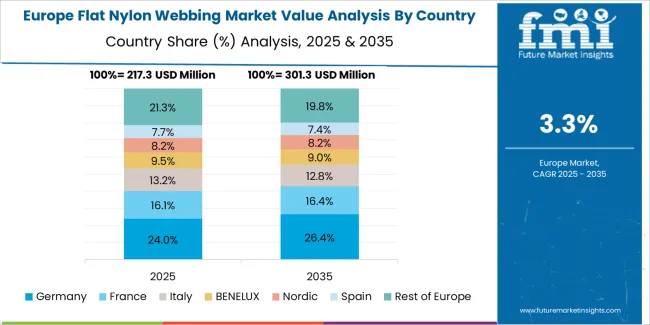
The flat nylon webbing market in Europe is projected to grow from USD 168.4 million in 2025 to USD 251.2 million by 2035, registering a CAGR of 4.1% over the forecast period. Germany is expected to maintain its leadership position with a 28.7% market share in 2025, declining slightly to 28.2% by 2035, supported by its advanced automotive manufacturing base and major outdoor equipment production facilities including established safety component suppliers.
France follows with a 17.4% share in 2025, projected to reach 17.8% by 2035, driven by comprehensive automotive component production operations and outdoor equipment manufacturing capabilities at major production centers. The United Kingdom holds a 16.2% share in 2025, expected to decrease to 15.7% by 2035 due to post-Brexit manufacturing adjustments and supply chain reconfigurations. Italy commands a 14.8% share, while Spain accounts for 12.1% in 2025. The Rest of Europe region is anticipated to gain momentum, expanding its collective share from 10.8% to 11.9% by 2035, attributed to increasing webbing adoption in Eastern European automotive component facilities and growing outdoor equipment manufacturing operations implementing certified material systems.

Japanese flat nylon webbing operations reflect the country's exacting quality standards and sophisticated technical expectations. Major automotive manufacturers including Toyota, Honda, and Nissan maintain rigorous material qualification processes that often exceed international standards, requiring extensive testing documentation, performance verification protocols, and supplier audits that can take 12-18 months to complete. This creates high barriers for new webbing suppliers but ensures consistent material quality that supports vehicle safety system reliability.
The Japanese market demonstrates unique application preferences, with significant demand for precisely controlled tensile strength specifications and specific elongation characteristics tailored to automotive safety system requirements. Companies require exact breaking strength parameters and environmental resistance specifications that differ from Western applications, driving demand for customized testing protocols and comprehensive technical documentation.
Regulatory oversight through the Ministry of Land, Infrastructure, Transport and Tourism emphasizes comprehensive material testing and safety certification requirements that surpass most international standards. The automotive component approval system requires detailed material qualification documentation, creating advantages for suppliers with transparent quality control processes and comprehensive testing capabilities.
Supply chain management focuses on relationship-based partnerships rather than purely transactional procurement. Japanese companies typically maintain long-term supplier relationships spanning decades, with annual quality reviews emphasizing material consistency and technical support over price competition. This stability supports investment in specialized testing equipment tailored to Japanese specifications and enables collaborative safety system development programs.
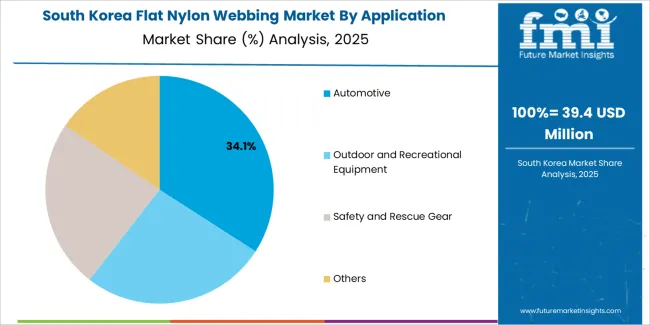
South Korean flat nylon webbing operations reflect the country's advanced automotive manufacturing sector and quality-oriented business model. Major automotive manufacturers including Hyundai, Kia, and SsangYong drive sophisticated webbing procurement strategies, establishing direct relationships with certified suppliers to secure consistent material quality and technical support for their safety system operations targeting both domestic and international markets.
The Korean market demonstrates particular strength in applying webbing materials to advanced automotive safety systems, with companies integrating certified textile components into products designed for global vehicle platforms. This technical focus creates demand for specific material specifications that differ from commodity applications, requiring suppliers to provide comprehensive testing documentation and quality verification support.
Regulatory frameworks emphasize material safety and traceability, with Ministry of Trade, Industry and Energy standards often exceeding international requirements. This creates barriers for smaller webbing suppliers but benefits established producers who can demonstrate comprehensive certification capabilities. The regulatory environment particularly favors suppliers with detailed testing records and quality management systems.
Supply chain efficiency remains critical given Korea's automotive export orientation and component quality requirements. Companies increasingly pursue long-term supply agreements with webbing manufacturers to ensure reliable material performance while managing quality validation timelines. Technical support investments enable material optimization and safety system integration during vehicle development programs.

Profit pools are consolidating around vertically integrated manufacturers with nylon yarn production capabilities and established automotive industry relationships. Value is migrating from commodity webbing to certified safety-grade materials where testing documentation, quality consistency, and technical support command premiums. Several competitive archetypes define market structure: global textile companies with diversified webbing portfolios and comprehensive certification libraries; specialized narrow fabric manufacturers focusing on automotive and safety applications with deep technical expertise; regional webbing suppliers serving local equipment manufacturers with cost advantages and responsive service; and contract weavers providing private label production for branded safety equipment companies.
Switching costs stabilize incumbent positions through safety certification requirements, automotive qualification protocols, and application-specific testing validation. Automotive component manufacturers invest 9-15 months qualifying new webbing sources, creating barriers that protect established suppliers. Performance specifications for breaking strength, elongation characteristics, and environmental resistance establish quality thresholds that limit competitive entry. However, material innovations in high-tenacity yarns and finishing treatments periodically create opportunities for technically capable suppliers.
Market dynamics favor manufacturers with comprehensive certification documentation spanning multiple safety standards and automotive specifications. Technical service capabilities that support application engineering, testing coordination, and quality troubleshooting create differentiation in automotive and safety segments. Supply chain integration from nylon polymer sourcing through final webbing production enables cost management and quality control advantages. Geographic proximity to automotive assembly centers and outdoor equipment manufacturing clusters reduces logistics costs and enables responsive technical support, particularly valuable in Asia Pacific markets where production concentrates.
Consolidation continues as webbing manufacturers seek scale economies to support certification investments and global distribution networks. Vertical integration opportunities attract automotive component suppliers seeking material control, though specialized weaving expertise limits backward integration. E-commerce platforms enable direct sales to small equipment manufacturers and DIY markets but safety-critical applications maintain distributor importance. Do now: secure automotive component manufacturer partnerships through comprehensive safety certifications and quality documentation; establish production presence in Asia Pacific automotive manufacturing centers. Option: develop recycled nylon webbing specifications addressing sustainability requirements in outdoor equipment segments.
| Stakeholder Type | Primary Advantage | Repeatable Plays |
|---|---|---|
| Global textile companies | Diversified portfolios, certification libraries | Multi-application products, safety testing, global supply |
| Specialized narrow fabric manufacturers | Application expertise, automotive relationships | Technical support, quality consistency, certification management |
| Regional webbing suppliers | Cost position, local presence | Responsive service, competitive pricing, custom production |
| Contract weavers | Manufacturing efficiency, production flexibility | Private label capacity, cost optimization, volume scaling |
| Items | Values |
|---|---|
| Quantitative Units | USD 842.9 million |
| Product Type | Normal Type, Heavy Type |
| Application | Automotive, Outdoor and Recreational Equipment, Safety and Rescue Gear, Others |
| Regions Covered | North America, Latin America, Europe, Asia Pacific, Middle East & Africa |
| Countries Covered | United States, Germany, China, India, Brazil, United Kingdom, Japan, and other 40+ countries |
| Key Companies Profiled | National Webbing Products, Strapworks, Murdock Webbing, Bally Ribbon Mills, Seattle Fabrics, Weaver (Xiamen) Textile, Webbing Depot, Bainbridge International, Country Brook Design, Bowmer Bond, ACWN, Nilit, US Cargo Control, John Howard Company |
| Additional Attributes | Dollar sales by product type/application, regional demand, competitive landscape, normal vs. heavy type adoption, safety certification integration, and material innovation driving tensile strength enhancement, durability improvement, and application versatility |
The global flat nylon webbing market is estimated to be valued at USD 842.9 million in 2025.
The market size for the flat nylon webbing market is projected to reach USD 1,212.2 million by 2035.
The flat nylon webbing market is expected to grow at a 3.7% CAGR between 2025 and 2035.
The key product types in flat nylon webbing market are normal type and heavy type.
In terms of application, automotive segment to command 34.1% share in the flat nylon webbing market in 2025.






Full Research Suite comprises of:
Market outlook & trends analysis
Interviews & case studies
Strategic recommendations
Vendor profiles & capabilities analysis
5-year forecasts
8 regions and 60+ country-level data splits
Market segment data splits
12 months of continuous data updates
DELIVERED AS:
PDF EXCEL ONLINE
Flat Suction Cup Market Size and Share Forecast Outlook 2025 to 2035
Flat Vacuum Suction Cup Market Size and Share Forecast Outlook 2025 to 2035
Flat Bag Back-blowing Dust Collector Market Size and Share Forecast Outlook 2025 to 2035
Flatback Tape Market Size and Share Forecast Outlook 2025 to 2035
Flat Rack Containers Market Size and Share Forecast Outlook 2025 to 2035
Flatting Agents Market Size and Share Forecast Outlook 2025 to 2035
Flatbed Die Cutters Market Size and Share Forecast Outlook 2025 to 2035
Flat Panel Antenna Market Size and Share Forecast Outlook 2025 to 2035
Flatbed Trucks Market Size and Share Forecast Outlook 2025 to 2035
Flat Valve Caps And Closures Market Size and Share Forecast Outlook 2025 to 2035
Flat Bottom Pouch Market Size and Share Forecast Outlook 2025 to 2035
Flat Bottom Bags Market Size and Share Forecast Outlook 2025 to 2035
Flat Glass Market Growth & Demand 2025 to 2035
Flat Panel Display Market Analysis by Technology, Application, and Region through 2025 to 2035
Flatware Market Analysis - Growth & Demand Forecast 2025 to 2035
Flat Panel X-Ray Detectors Market Analysis by Application, Product, and Region Forecast Through 2035
Analyzing Flatback Tape Market Share & Industry Leaders
Leading Providers & Market Share in Flat Bottom Pouch Manufacturing
Market Share Insights of Leading Flat Glass Coating Providers
Flat Steel Market Growth – Trends & Forecast 2024-2034

Thank you!
You will receive an email from our Business Development Manager. Please be sure to check your SPAM/JUNK folder too.
Chat With
MaRIA